How to use sketchbooks
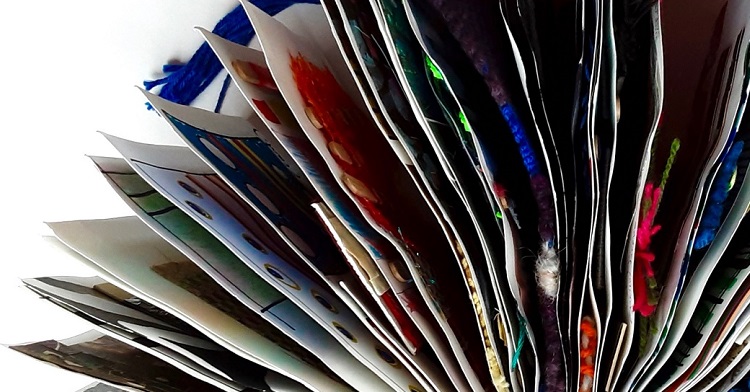
A sketchbook can be a beneficial tool, the key to achieving sustained progress in your artwork. Sketchbooks can be used in all sorts of ways, even if you don’t consider yourself good at drawing. You might use them to consolidate your thoughts, or do some planning work. You can use them to record a visual snapshot of the things you see around you, or make them a repository for samples and interesting collected items.
If you do love drawing, a daily sketch habit might help you escape that frustrating stop-start process. Using a sketchbook can help you get into a positive and creative mindset, or provide a useful reference guide when you are stuck for ideas.
Artists work in many different ways so it makes sense to tailor how you use a sketchbook to suit your personality and nature.
Some people have an in-built drive, an urge to make, finding it easy to jump into their projects and develop a regular and rewarding creative practice. For these artists, a sketchbook can be useful for collecting observations, making plans and keeping on top of their ideas and creative energy.
Other artists work in fits and starts, flitting between ideas. This might be a preferred way of working, or perhaps these artists dream of being more productive and self-disciplined. A sketchbook might help ease these artists into ‘creative-mode’ and develop a more consistent way of working.
At art school, students are encouraged to use sketchbooks daily. And there’s a reason for this: it helps them to focus, observe, and evolve their ideas and inspirations, by getting them down on paper. By doing this on a regular basis, they start to build a creative habit.
In this interview we’ll be exploring how textile artists use sketchbooks.
Top textile artists Alisa Banks, Merill Comeau, Andrea Cryer and Shelley Rhodes share their sketchbook suggestions. What’s interesting is how they use sketchbooks in different ways, to suit their styles of work and their personalities.
So while you’re pondering how using a sketchbook might help you, read on for inspiration. The featured artists’ sketchbook habits and practical suggestions might just give you the jump-off point you need to get started.
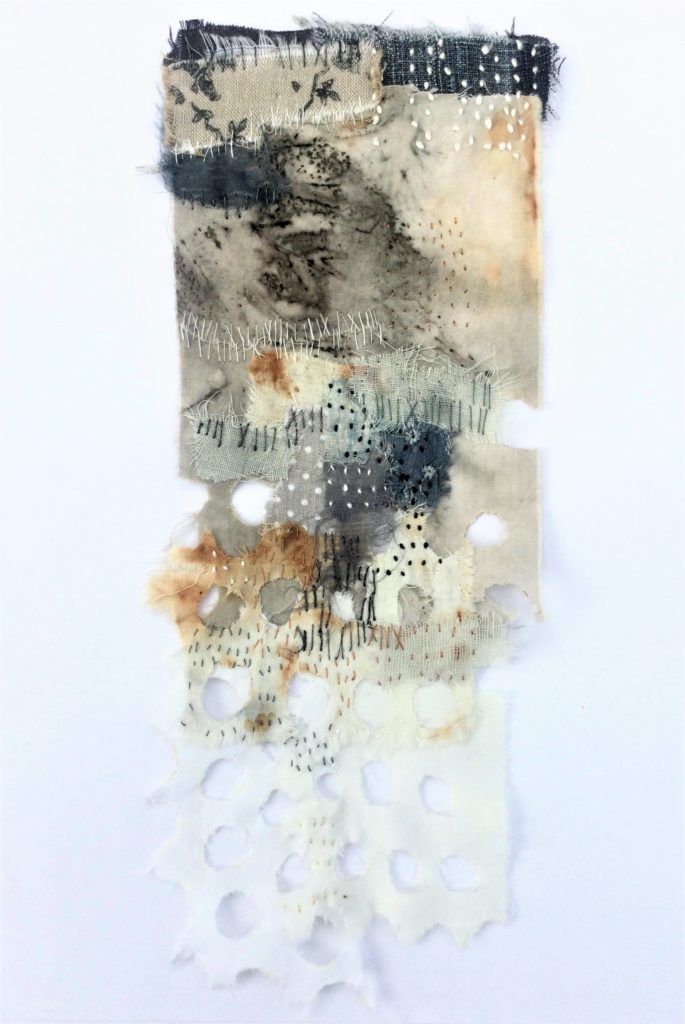
Shelley Rhodes
Shelley Rhodes is a contemporary mixed media artist based in Cumbria, UK. She describes herself as an artist, traveller, collector, arranger, sketcher and stitcher. Her artwork mixes fabric, paper and stitch with drawings and prints, and she loves to build up layers, editing and altering them as the work progresses. She is inspired by architecture, the environment and discarded items, habitually recording her observations in sketchbooks and journals. She makes a small piece of artwork every day, which she posts on Instagram.
Website: www.shelleyrhodes.co.uk
Facebook: shelleyrhodesmixedmediaartist
Instagram: @shelleyrhodesartist
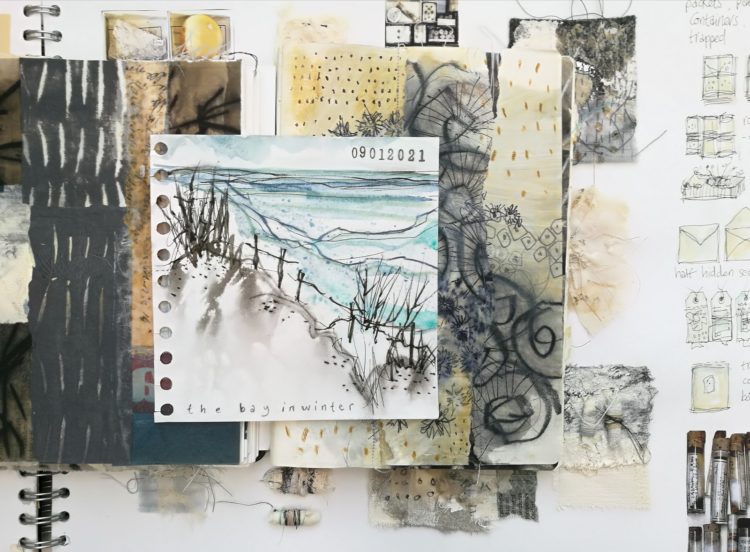
The sketchbook juggler
Shelley Rhodes works in several sketchbooks simultaneously. Her ongoing large A3 (US tabloid) workbook usually relates to a current theme she is exploring. It’s not just sketches in there though. She hoards photographs, research sources, notes, diagrams, samples, jottings about ideas, swatches of colour, and exploration and testing of materials. Her current workbook is full of ideas about coral bleaching and ocean plastic. She generates more ideas than she can resolve into finished work, but occasionally she finds it useful to look back and revisit an earlier idea.
As a sketchbook juggler, Shelley also has a book just for collage and another for text. In addition, she always carries a small book when travelling, usually a small handmade concertina book. And finally, to add to this collection, she also uses a small everyday sketchbook.
Shelley is a fan of spiral-bound books, pulling pages out to take with her on walks, instead of carrying a bulky book. Having filled a page, she pushes it back into the spiral binding for safe-keeping.
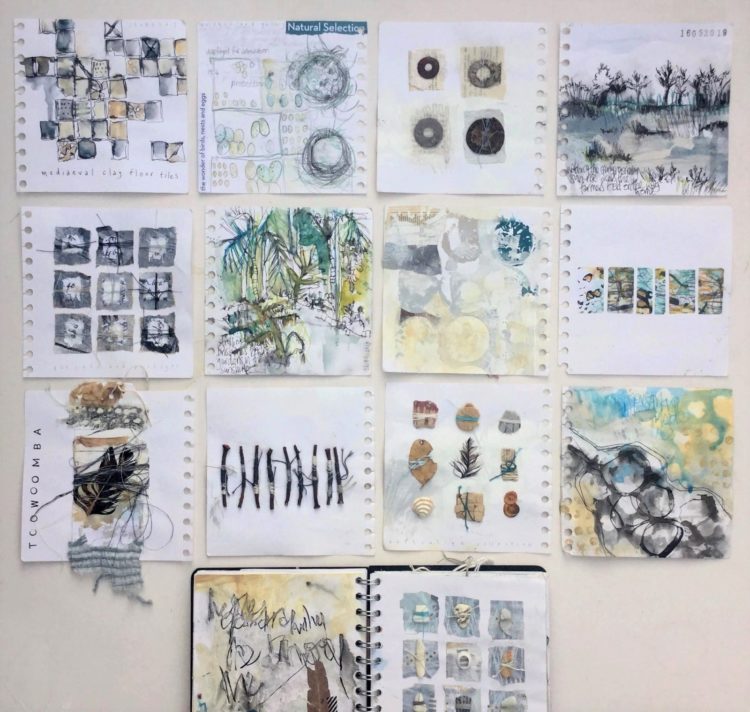
Shelley’s daily sketch
In Shelley’s small everyday sketchbook (15 cm x 15 cm) she has made it a habit to create one small piece of art every day.
This might be a quick sketch, observational drawings, collage, a print, an arrangement of a collection or a presentation of found objects. Sometimes it is simply an extraction of colours, marks or textures. She makes marks on paper, on fabric or a combination of the two. Sometimes she includes threads, stitch, wax, wire, tape, staples and pins. In fact anything goes, so long as it makes her think creatively!
And the key to maintaining her sketchbook habit? Shelley posts these pages daily on Instagram, to ensure that she does it!
Shelley nearly always draws directly from what she can see, rather than working from photographs. This usually limits her time, helping to make her marks looser and more energetic. Until recently she always worked on both sides of the page, embracing and working with any marks that bled through. However, now she has started working on a single side of the page, enabling her to sell some of her drawings.
If someone recommends an artist, book, interesting website or product Shelley makes written notes on the pages at the back of the book, rather than jotting them down randomly throughout the book, so if she wants to refer to something she can always find her notes instantly.
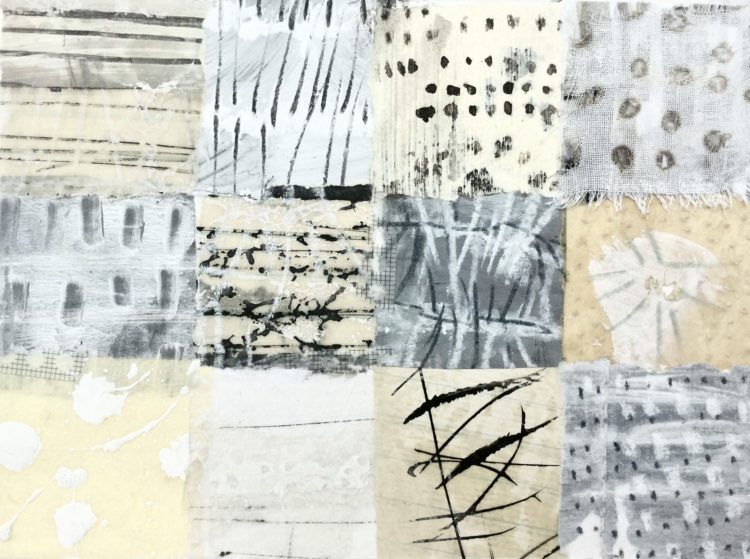
Creating a sketchbook habit
Alongside making sure she publishes her sketchbook pages on Instagram every day, Shelley has another trick up her sleeve. She keeps a small box in a corner of her kitchen, containing a selection of her favourite art materials. This means everything is to hand and she can make effective use of any spare minutes.
Shelley suggests setting an achievable sketchbook goal and sticking to it; whether it is ten minutes a day or once a week. But most of all she encourages you to take the pressure off and just enjoy the process of filling a sketchbook.
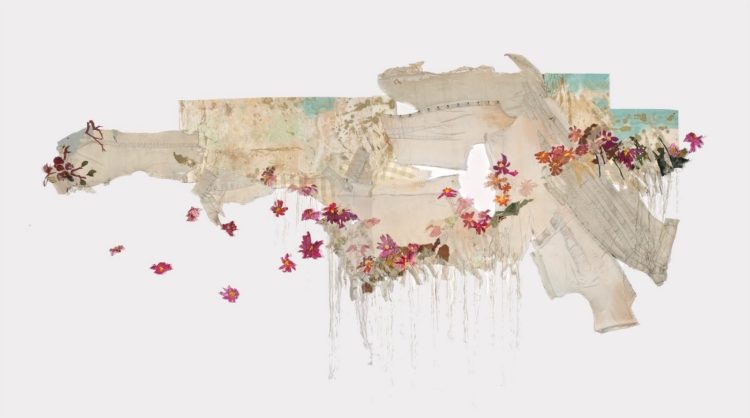
Merill Comeau
Merill Comeau’s textile installations, wall hangings and garments are composed of worn domestic fabrics, mended and stitched together. Merill, based in Massachusetts, USA, uses her work to comment on socio-political issues, and to explore ideas around memory, repair and regeneration, and women’s experiences. She exhibits regularly in the US and has facilitated numerous collaborative community art projects.
Website: www.merillcomeau.com/
Facebook: www.facebook.com/MerillComeau
Instagram: @merillcomeau
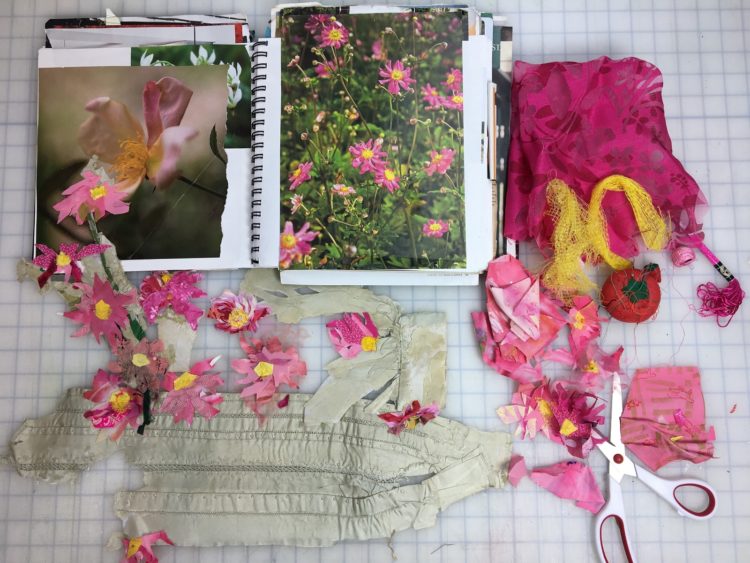
Sketchbooks for different activities
Merill Comeau keeps four active sketchbooks. These are around 25 cm to 30 cm square with metal spiral bindings; these bindings allow her the expansion space to stick in lots of additional materials.
The first book is filled with pasted-in print images that inspire repetitive pattern ideas, for when she is designing fabric printing blocks. Building facades, a bird’s-eye view of farm fields, or decorative domestic objects such as china or rugs can all inspire a multitude of shapes, arcs, angles, zigzags and dots.
The second book is filled with images of flora including vegetable and flower gardens, fern-filled woodlands, stands of grasses, and fruit trees. These images of live plants are especially helpful in winter, when the ground is covered in snow, as Merill relies on them to create her “Fragments of Eden” landscape series.
The third sketchbook is filled with plants that Merill has drawn en plein air. This is a sketchbook she most often uses at artist residencies, when she has the time to sit outside and focus. Every summer she tells herself to develop a daily practice with this sketchbook, but she is still working on this goal.
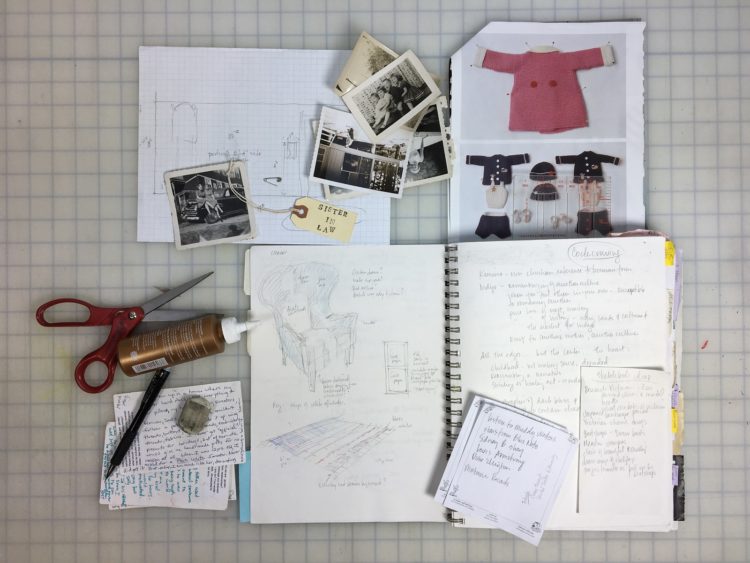
Merill’s sketchbook goulash
Merill’s fourth book is her most utilitarian. She add to this one frequently, and it sits within reach on her work table at all times. This is her storehouse; it is crammed with notes, lists, quick sketches, musings on conceptual underpinnings, imagined artworks, titles under consideration, snippets of memories, exclamations of desire, and practical solutions to conundrums. Integral, related, tangential, and extraneous considerations are recorded as they course through her mind.
Sometimes Merill draws diagrams to solve visual problems and guide her design decisions of colour and size. Sometimes she glues in notes. These might be jottings she’s brought back to the studio from the field, the train, or her bedside.
This day-to-day sketchbook is a mixed-up goulash of material; chronologically recorded thoughts landing on the next available blank space whenever inspiration strikes! Here she can also store notions so they are not forgotten.
Periodically, Merill reviews this collection and adds tabs to pages, identifying categories or topics such as ‘garments’, ‘wall work’, or title ideas. This allows her to flip through and find related information related to a current need.
By placing her deliberations safely onto pages, Merill can retrieve them at any time; this sketchbook provides valuable storage and allows her to put distracting items temporarily out of her mind while she focuses on the visual work at hand in the studio.
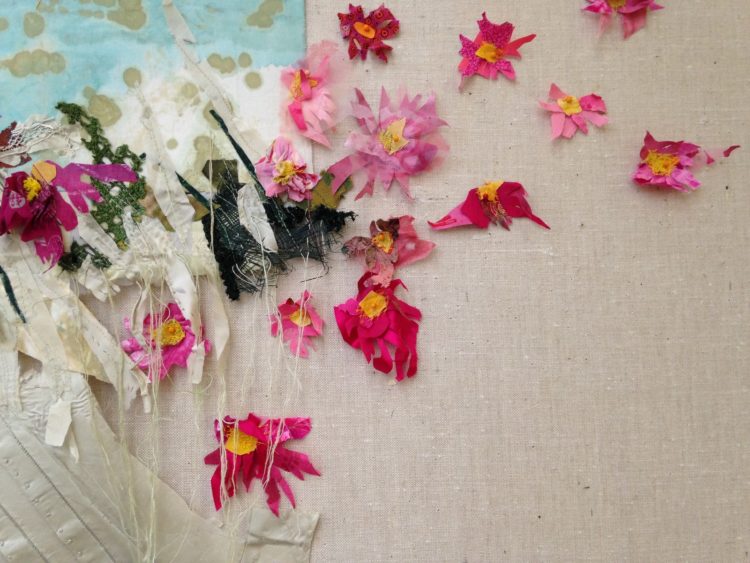
Usefulness over beauty
Many people’s sketchbooks are objectively beautiful works of art. Merill feels that hers, as messy, overstuffed, disorganised, utilitarian repositories, are only beautiful to herself. Long ago she dropped any preconceived sketchbook practices and chose to go her own unfettered way.
She assembles and uses her books however she wants, without any thoughts of an external viewer. Merill told us, ‘They suit me, they support my process, and I love them!‘
Her tip for makers who want to make better use of their sketchbooks is to ‘let go, collect, and see what accrues‘.
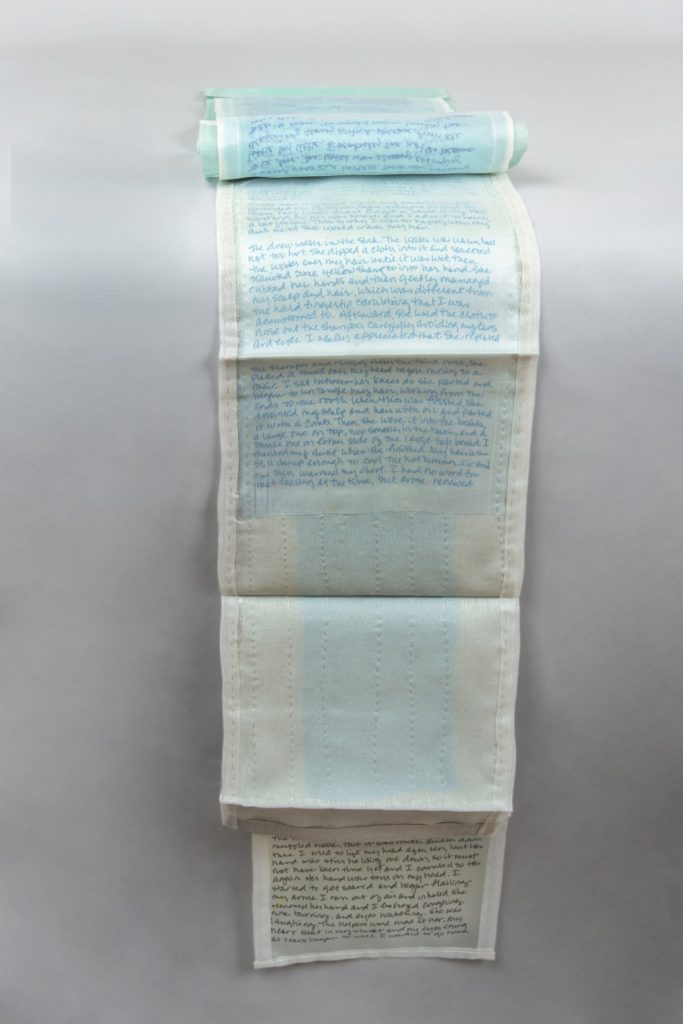
Alisa Banks
Visual artist Alisa Banks, based in Texas, US, examines the concepts of body, place and home, and relates them to broader issues within culture and society. Her elegantly stitched work combines a mixture of textiles and found materials, and references traditional craft techniques. Alisa’s work has been exhibited internationally and is in several collections in the US. Her work is created through an extensive process of research, elaboration and editing, in order to communicate her chosen story to the viewer.
Website www.alisabanks.com/
Facebook: www.facebook.com/Alisa-Banks-Art-467921510372238
Instagram: @abanksart
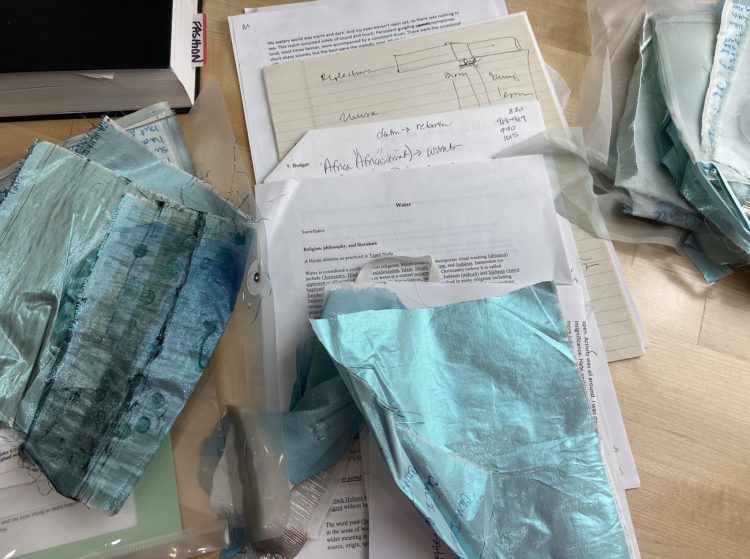
From sketchbooks to folders
In common with the other artists featured in this article, textile artist Alisa Banks also has several sketchbooks on the go at once.
Alisa tells us that some are for general use, and others are loosely categorised by the type of project; this might be textile collage, book projects or essays. She also has a notebook containing swatches of colours that she finds interesting.
When Alisa decides to develop an idea further, she places supplementary materials, sketches and notes into a dedicated folder for that project. This ‘inspiration folder’ contains everything she needs for her research and development phase, all safely stored in one place.
Pencil and pen are her preferred media. Most of Alisa’s books are hardback or spiral-bound. Her books range in size; she has small and medium sketchbooks, three pamphlet/soft cover books and one very large, hardback sketchbook.
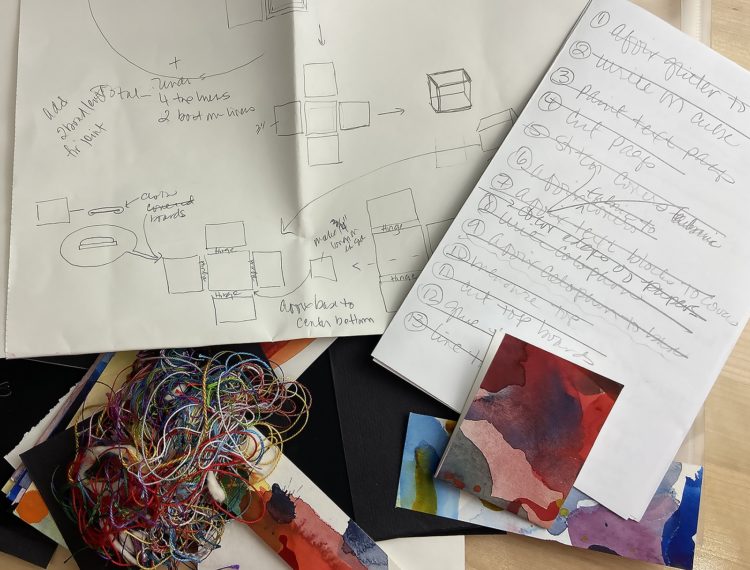
Alisa the list-maker
Alisa’s books are text-heavy, so for all you list-makers out there, this approach might work well for you, too.
She writes notes, makes lists and, although she doesn’t sketch in them daily, it is not uncommon for her to have a notepad nearby to jot down a quick thumbnail sketch or note. She is an avid list-taker and writes a daily “to do” list on a spiral steno-pad/shorthand notebook kept on her desk.
Alisa told us, ‘I’m also known for getting up in the middle of the night to write down an idea or sketch a quick outline!‘
As far as her sketchbooks are concerned, Alisa tends to jump from one to another, although nowadays she is trying to jot all new ideas in her big book. Her early sketchbooks consisted mainly of pencil or charcoal drawings, but over time, they’ve become much less formal.
Every so often, she will return to her earlier books to see her thought process and sometimes she finds a real gem or two, proving that noting down ideas can pay dividends later on.
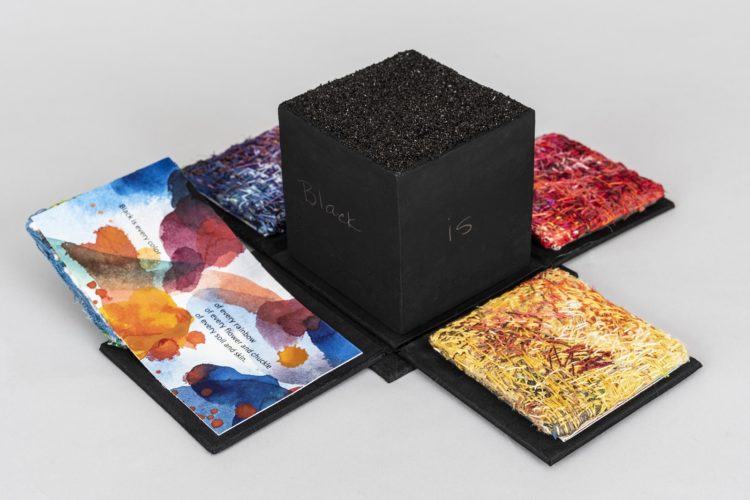
Folders of inspiration
Alisa’s tip is to not put pressure on yourself, especially when it comes to how often you use your sketchbooks.
She put pressure on herself when she first started using sketchbooks; she was aiming to use them regularly and fill them with formal drawings. Now, Alisa has a more relaxed approach and she finds that, because her current books contain project ideas and inspiration, she uses them more frequently. Her sketchbooks have transformed into an incredibly useful tool.
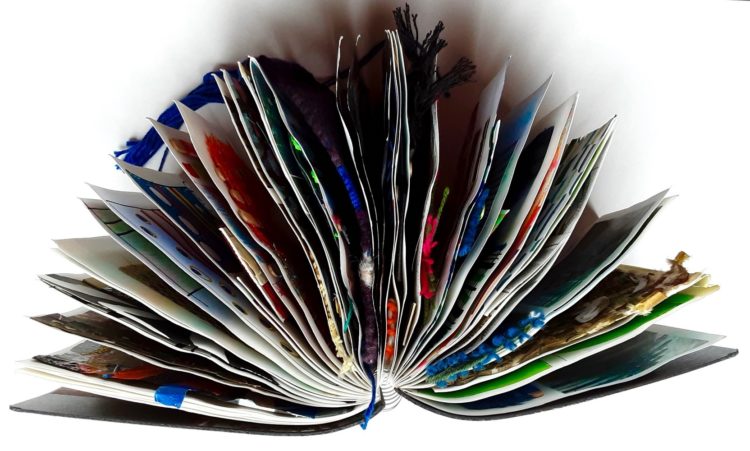
Andrea Cryer
Andrea Cryer is a textile artist based in the UK. She creates unique portraits and landscapes beautifully drawn with thread, using a continuous process of decision-making and mark-making. Her work is hand and machine-stitched, then coloured using disperse dyes and pastels. Andrea holds a BA (Hons) in Creative Art (Fine Art & Textiles) from Bath Spa University and exhibits her works in the UK and internationally.
Website www.andreacryer.co.uk/
Facebook: www.facebook.com/Andrea-Cryer-Textile-Artist-290817971094773/
Instagram: @andreacryerartist
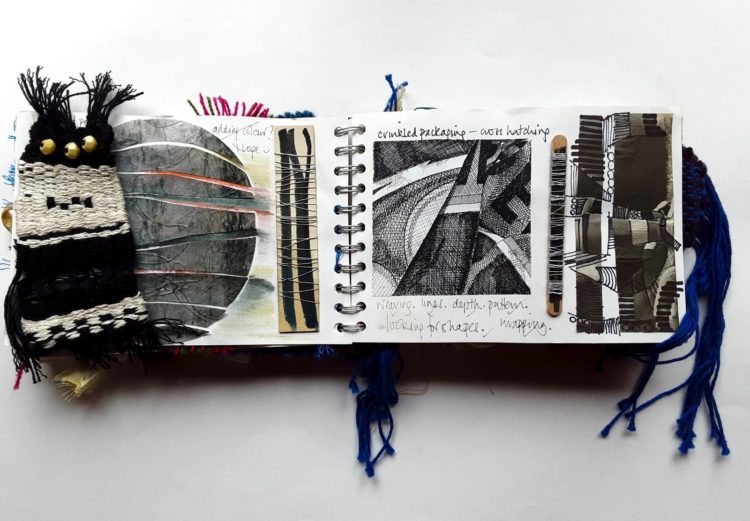
The ideas collector
Andrea Cryer is another artist who uses a variety of sketchbooks and folders, ranging from small compact homemade books containing colour swatches and process notes, through to spiral-bound books, and large sketchbook folders housing loose leaf drawings, mixed media work, stitched and embellished textiles and fabric samples.
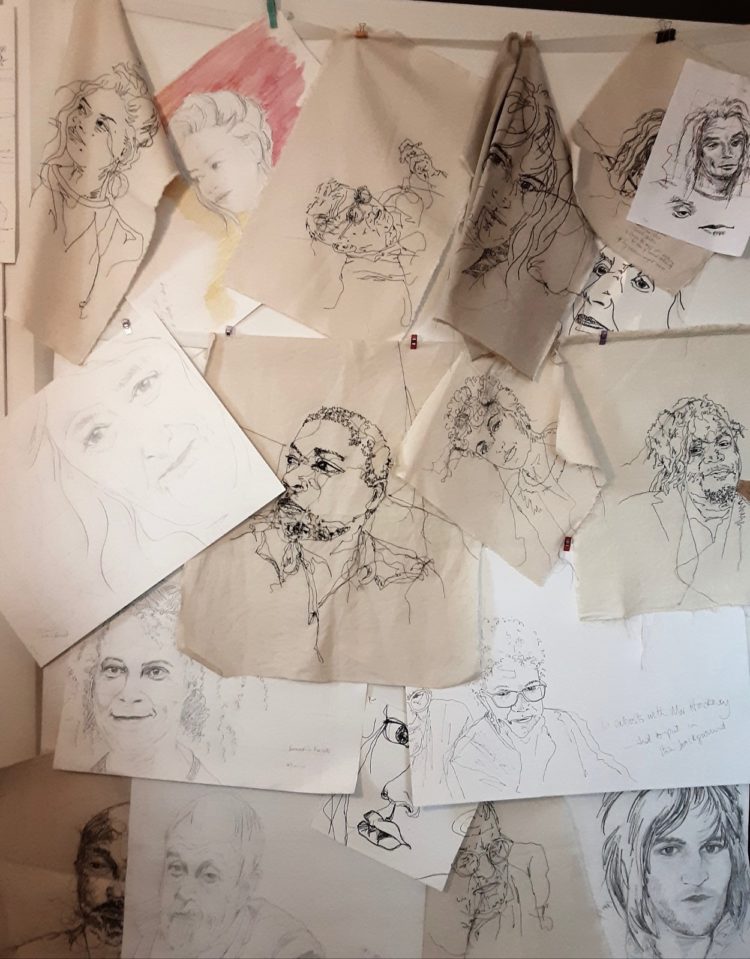
Sketchbooks and sketch-boards
Andrea acquired the sketchbook habit via a traditional route, using them regularly during her art student days. She first used sketchbooks whilst studying on a Foundation course as a mature student, where she regularly cut up, tore and reconfigured standard issue sketchbooks to alter their format. This playing with scale would inform her approach to the subject matter, within a newly-constrained size and shape. The students were encouraged to seek out structures, detail, pattern and texture as well as considering the overall composition. This was a very enlightening and challenging approach, which has stood her in good stead, particularly when tackling life drawing through looking at negative spaces and isolating specific areas, in addition to considering the figure as a whole.
Andrea’s sketchbooks developed in a different way during Creative Arts degree in Fine Art and Textiles. For this, she studied a number of modules including knit, stitch, weave, print, sculpture and fashion design. Her sketchbooks soon became full and overflowing, with textural pieces escaping from every page!
Drawings, prints, woven and knitted samplers, embroidered panels, photographs from magazines, postcards from art gallery and museum visits and all manner of ephemera found their way onto these pages. Andrea has since combined some of these sketchbooks, filling in any empty-looking pages and adding to them as the years have passed by. She still gets pleasure from revisiting these sketchbooks today.
These days, as a textile artist, Andrea often uses a ‘sketch-board’. This is, in effect, a vertical sketchbook with two large ‘pages’ which she can rest against a wall, desk or shelving. It is made from a large art canvas (1.2 m x 1.8 m /4′ x 6′), around which she has stretched rings of elastic.
To the front and back of the canvas she attaches preparatory drawings, notes, inspiration and works in progress to any or all of the elastic bands, at different heights, without committing to a permanent arrangement. The displayed pieces of work, whether fabric or paper, are easily interchangeable and allow her to assess and reflect on where she might be going with a particular project or commission.
The sketch-board lets Andrea view her work from a distance, which often makes it easier to spot where changes need to be made. When the work is finished, she can quickly and easily remove the collaged pages and store them as a sketchbook folder.
Andrea finds that this sketch-board system works really well for displaying portrait pieces as well as arranging hand-dyed and painted papers or fabrics when introducing colour to her artwork. Another advantage is that it is very lightweight and easy to move around!
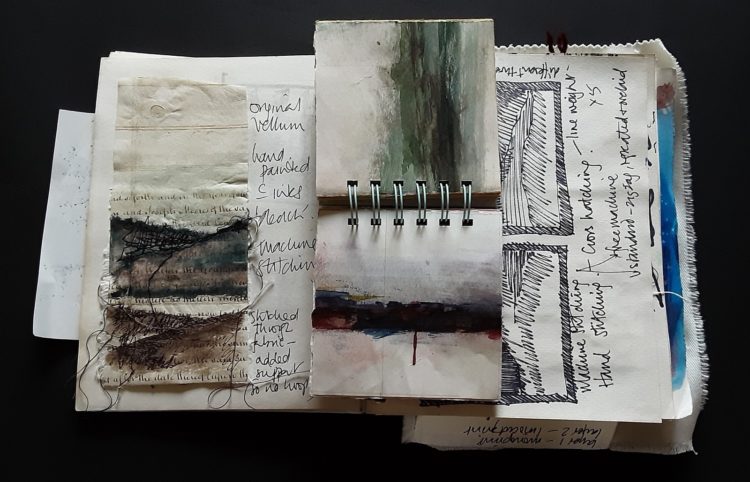
Fight the sketchbook fear!
Andrea’s tip for using a sketchbook is to remember there are no rules, so don’t be fearful of a blank white page. She says, ‘Just go for it!’
Sketchbook success
The four textile artists featured in this article all have several sketchbooks on the go, using them for different situations and various types of content. They use their sketchbooks according to their individual needs, making them an important part of their toolkit. We’ve seen that it’s a good idea to use spiral-bound books, which provide some expansion space between pages to collect and store samples, objects and other items alongside your notes and sketches.
Sketchbooks don’t have to beautiful, they are just there for you to collate your resources, whether it is text snippets, sketches, designs, colour tests, samples, objects, collected items, photographs or anything else, as long as it gets you thinking.
These artists have shown that the key to success with sketchbooks is to use them in a way that suits you best. This might be to make a daily drawing, or to use them as a tool for gathering inspiration, or for developing projects.
Anything goes; you don’t have to sketch in a sketchbook, and you don’t have to use it every day!
So go ahead, choose a beautiful (spiral-bound!) sketchbook or two, and run your hands over the tactile, thick paper. Select your preferred mark-making implement; a fine-liner pen, a freshly-sharpened pencil or maybe some watercolour paints. Then sketch some ideas, write some notes, glue in some photos, collect objects, papers or fabric samples, make some plans, or test out colours and patterns. Take the pressure off, open that first page and see what accumulates.
Most importantly, make your sketchbook work for you.
Did you enjoy this article? If so, why not share it with your friends using the buttons below.
















I do enjoy TextileArtist.org because every time I visit I discover something new that I couldn’t think possible to do! Always something new…. I hope some day I’ll be able to do something new myself!
Lovely thought provoking ideas, thanks.
I love your newsletters. It’s breathing some fresh embroidery air. Thank you.
Thank you for the encouragement these articles on using sketch pads gives!
Wonderful ideas, thanks for sharing!
Love fabric, and sketchbooks!.
How refreshing! I’ve been told off on several courses because I don’t use a traditional sketchbook – lovely to look at and oh so considered as an item in its own right. I use a book for recording thoughts in word and images and add drawings and try-outs, often done on the back of recycled letters, etc, plus textile and thread samples that bulge out beyond the edges. As Merill says, it’s for her, a working companion that is meaningful only to her. I could not do without my ‘work books’ that I have never before dared to call ‘sketch books’. Thank you to the contributors to this article for their honesty and reassurance about what constitutes a sketchbook.
I love these – they’re so inspiring! I recently forwarded these on to a good friend who is a teacher so she can hopefully get some inspiration too!
Thank you for sharing these treasures of sketch books. It makes me confident in continuing to use various sketch books for different purposes/subjects/materials. I really much appreciate this.
Best regards
Carmen
Well collated article, very inspirational and practical. I could not wait to give it a try today, 1 May a meaningful day, despite all the incomplete previous attempts. 😜
Such a useful and inspirational article. Currently have several different old exercise books for ideas but there are some larger spiral sketchbooks waiting for me to broach them! Here goes!😀
Look forward to receive your emails
I love this article. I have several sketch books. All of them have snippets of drawings etc. I always thought I should make them beautiful but now I seem to have been given permission to just pop all my thoughts and stuff into them. Here I go. Thank you.
Very interesting view on how a sketch book can look like and bei user for. Thanks for a new view.
Found this article so very inspiring’ in particular the stand up one with elastic , holding snippets and notes.
I have several unused large canvasses standing around, which I bought in a sale and waiting to be painted on.
They’ll be ideal, rather than just standing lonely doing nothing!
I’m so enthused, as I drown in snippets of paper and ideas every where!
Thank you so much.
May I suggest,to republish this article once a year or so, as a reminder and also for newcomers into our art world!
I too call mine a workbook! I have seen other people’s beautiful sketchbooks which has totally stopped me from calling my random ideas, magazine cuttings, and experiments a sketchbook. Apart from which my drawing skills are severely limited! At the end of the series of experiments, I add relevant fabric and stitch samples and a photo of the finished piece as a record and reminder of how I worked. This works for me! Perhaps I’ll call it a sketchbook now.